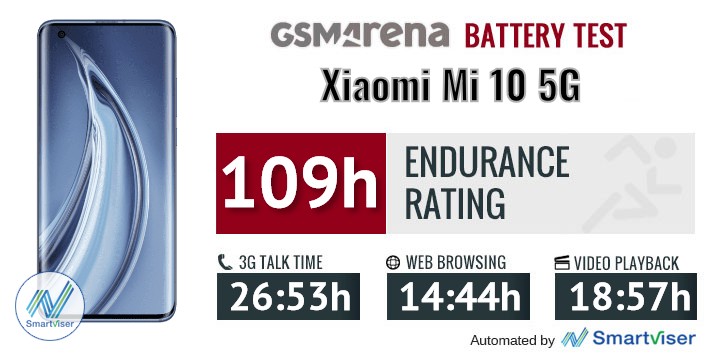Xiaomi Mi 10 5G review
Introduction
Back in February, Xiaomi unveiled the Mi 10 family of devices. One that seems to be still expanding, with increasingly-interesting value offers, like the Mi 10 Youth 5G, no less. We already did a deep dive on the top-dog Mi 10 Pro 5G, which you can check out here. A true 2020 flagship, which shines particularly bright with a versatile camera setup. But also, features a nearly $1,000 price point, which is a bit hard to swallow.
Enter the vanilla Xiaomi Mi 10 5G - a device that look and feels literally identically premium, yet manages to slash a few bucks off the price tag. However, it does so by meddling with the versatile Mi 10 Pro camera setup, which we liked so much.
Xiaomi Mi 10 5G specs:
- Body: 162.5x74.8x9mm, 208g; curved Gorilla Glass 5 front and back, metal frame; splash resistant; Coral Green, Twilight Grey, Peach Gold color schemes.
- Screen: 6.67" Super AMOLED, 1080x2340px resolution, 19.5:9 aspect ratio, 386ppi; 90Hz refresh rate; HDR10+ support.
- Chipset: Snapdragon 865 (7nm+): Octa-core CPU (1x2.84 GHz Kryo 585 & 3x2.42 GHz Kryo 585 & 4x1.8 GHz Kryo 585); Adreno 650 GPU.
- Memory: 8/12GB RAM, 128/256GB built-in UFS 3.0 storage.
- OS/Software: Android 10, MIUI 11.
- Rear camera: Wide (main): 108MP, 1/1.33" sensor, 0.8µm pixel size, 25mm equiv. focal length, f/1.69 aperture, PDAF, OIS. Ultrawide angle: 13MP, 12mm, f/2.2, fixed focus. Macro: 2MP, f/2.4, autofocus. Depth module: 2MP, f/2,4.
- Front camera: 20 MP, f/2.0, 0.9µm, 1080p video.
- Video recording: Rear camera: 8K 4320p@30fps, 4K 2160p@30/60fps, FullHD 1080p@30/60fps; Front camera: FullHD 1080p@30/60fps.
- Battery: 4,780mAh, 30W fast charging support, USB-PD support, 30W wireless charging, reverse wireless charging.
- Connectivity: 5G, Bluetooth 5.1, NFC, Wi-Fi a/b/g/n/ac/ax, dual-band GPS, USB 2.0 Type-C, IR port.
- Misc: Dedicated symmetrical stereo speakers; Optical under-display fingerprint reader.
Beyond that and some minor battery upgrades and charging downgrades, the Mi 10 5G manages to otherwise remain practically identical to its bigger brother. The gorgeous, 6.67-inch, Super AMOLED, 90Hz, HDR10+ panel is still here. So is the Snapdragon 865 chipset, as well as all the other little extras and bells and whistles from the Pro with just few minor differences here and there.

We have little doubt that the Mi 10 5G will be an excellent flagship device in its own right. The one major question that remains then is whether or not it will offer good enough value, relative to the cutbacks from the Mi 10 Pro and the much cheaper Xiaomi devices like the Mi Note 10 Pro and the Mi 10 Youth 5G.

The writing is on the wall, and it's pretty clear that the vanilla Mi 10 5G finds itself weirdly sandwiched between great Xiaomi phones on both sides. And with more and more masonry work from other phone manufacturers filling in any remaining gaps, as well. We won't risk torturing that particular metaphor any further than that. So, without further ado, let's see if the Mi 10 5G has what it takes to make the most out of the tough spot it now occupies.
Unboxing the Xiaomi Mi 10
Unboxing the vanilla Mi 10 5G was actually quite interesting for us. Not that the package was anything special, we didn't get reviewer accessories or anything of the sorts. It's just that for the Mi 10 Pro 5G review, we experienced a couple of oddities in this department. One was the lack of a Type-C to 3.5mm dongle in the Pro's package. However, just as promised, now that we have a regular retail Mi 10, 8GB/256GB unit in Twilight Grey in our hands, the little dongle was present just like Xiaomi promised it would.
Also in the box, there is a pretty decent clear hard case. Always appreciated, since you can start confidently using your new device straight away.
On the flip side, unlike the Mi 10 Pro, which came with a very thin screen protector pre-applied. The regular Mi 10 had no such thing. Nevertheless, we have a fair bit of confidence in the Gorilla Glass 5 finish, which both the vanilla and Pro have on both their fronts and backs. So, the missing screen protector is really not a dealbreaker.

Last, but not least, we were also rather curious as to what charger Xiaomi would ship with the Mi 10, since the Mi 10 Pro arrived with a rather overpowered 65W PD unit. We do get the reason behind that, since 65W is kind of a popular design, which comfortably covers the 50W of charging the Pro can do and is presumably already in production by Xiaomi anyway for its laptops.
The retail vanilla Mi 10 package, however, only includes a 30W charger instead. Again, perfectly logical, since the 30W-spec charger is also a popular, mass-produced one. Plus, one of the downgrades the regular Mi 10 ended up with is a bump down to supporting only up to 30W of fast charging. So, a perfect match.
Design
There is a lot to love about the design of the Mi 10. It's the well-refined "glass sandwich" designed, complete with all of its benefits and drawbacks. The same goes for the increasingly-popular curved display. It is safe to say that if you find the Mi 10 Pro appealing, then the same will also be true for the vanilla version as well. Since the two are identical. We can only assume that saves Xiaomi some of the manufacturing costs. And, we really can't say we mind at all since the design in question is a trendy and great-looking one. Plus, case hunting for the Mi 10 should be a bit easier - Pro or vanilla - both work.

Anyway, with the Mi 10, you get a curved sheet of Gorilla Glass 5 on both sides. Nothing overly aggressive or too steep in terms of angles. The back panel extends a bit further up than the sides of the display go down, which is somewhat detrimental to symmetry. Still, it's the right approach, since an aggressively overflowing display often leads to touch and palm rejection issues, as well as control compromises. There is none of that on the Mi 10. The middle metal frame is still wide enough to accommodate both a traditional volume rocker and a power button. Both ergonomically positioned on the right-hand side.

The overall build of the Mi 10 feels really solid, with practically no flex whatsoever. Gorilla Glass 5 provides enough peace of mind as far as cracking are concerned, though, we would still recommend a case if you are a bit clumsy. Potentially, a screen protector, as well. But even those who do take extra good care of their handset could probably benefit from a case since the matte finish on the back of the Mi 10 is a real grease magnet. It is also very slippery. Unlike the Pro, which only comes on White and Gray, the regular Mi 10 offers a lot more color variety.

What we have at hand is the Twilight Grey, which can range in looks vastly from metallic to blueish and even slightly green, depending on light and angle. Coral Green and Peach Gold are potentially even more visually pleasing. So much so, that it could be a bit hard to cover them up with a case. Then again, the camera module on the Mi 10 protrudes quite a bit - all of which compeling reasons for snapping a case on the back.
Even with its extra slippery nature, the Xiaomi Mi 10 fits snugly and securely in hand, with the metal frame perfectly shaped to provide a little bit of extra grip. We do have to point out that the 13MP ultrawide camera - the bottom one in the camera roll, sits a bit too low. Expect to bump into it with an index finger quite frequently.

Quickly flipping the device over for a second, the punch-hole selfie camera is not overly obtrusive and fairly easy to get used to. The lens of the 20MP snapper is quite small compared to the entire size of the cut-out.
Neither the Mi 10, nor the Mi 10 Pro has an official ingress protection rating. Xiaomi claims that there is some splash-proofing on both. They can definitely survive some rain and probably a quick accidental dip in water too. Still, not going the extra mile to certify a premium flagship leaves a bit of a nasty aftertaste.
Controls
Just like the Mi 10 Pro, the vanilla version has a very traditional control layout. Biometric authentication is handled by an excellent optical under-display fingerprint module. It's both snappy and reliable.

There is no status or notification LED. Xiaomi expects its AOD options to replace that. Of course, we know it's not the same thing, and AOD does come with its own penalty. Though, credit where credit is due, most of the visuals and animations, like the one during charging are incredibly polished.
The speaker situation is a bit different and not strictly conventional on the Mi 10. At the very top edge, on the front, there is a tiny conventional earpiece. Just like its bigger brother, the Mi 10 has a pair of stereo speakers. One on the top side and another one at the bottom. Since the Mi 10 Pro set the bar pretty high with its stereo speaker performance, you are probably wondering how the vanilla stacks up. Jump on to the audio section for our review and check out the new speakerphone test.

Before we get to what is, spoiler alert, a pretty great all-round showing in audio output, we can't fail to mention that while we admire Xiaomi for their dedication and success in fitting these speakers in the Mi 10, their position could be better. Mostly, since, having the two grills on either side of the phone makes them pretty easy to cover up, while holding the device horizontally.

Rounding the controls tour off, we appreciate the inclusion of an IR blaster on the top bezel. The phone lacks a microSD slot and our particular unit only takes a single Nano-SIM. A pretty rare sight on a modern phone (not counting ones with an internal eSIM solution). This results in an odd-looking SIM tray, which almost seems to be taunting us with extra space on the plastic piece, just perfect for a microSD. That, of course, is there, simply because there is a dual-SIM version of the Mi 10, which has it occupied by the second Nano-SIM tray.
A large 90Hz display
One of the best things about the Xiaomi Mi 10 is that it gets the excellent panel of its bigger brother. It is a 6.67-inch, Super AMOLED unit, which can definitely stand its own in terms of quality compared to the competition.

Unfortunately, it's only FullHD+ in resolution (2,340 x 1,080 px). But, that still works out to a perfectly sharp 386ppi, or so. We find it more than adequate at this screen size. Plus, the lower resolution does theoretically mean better power efficiency. Though, granted, on an OLED, not too much.
The other potential point of scrutiny for the Mi 10's panel is the 90Hz refresh rate. While it is still great to have anything above 60Hz, current flagships are already raising the bar to 120Hz.
| Display test | 100% brightness | ||
| Black, | White, | ||
| 0 | 894 | ∞ | |
| 0 | 871 | ∞ | |
| 0 | 858 | ∞ | |
| 0 | 854 | ∞ | |
| 0 | 820 | ∞ | |
| 0 | 665 | ∞ | |
| 0 | 646 | ∞ | |
| 0 | 643 | ∞ | |
| 0 | 635 | ∞ | |
| 0 | 622 | ∞ | |
| 0 | 620 | ∞ | |
| 0 | 597 | ∞ | |
| 0 | 536 | ∞ | |
| 0 | 531 | ∞ | |
| 0 | 525 | ∞ | |
| 0 | 522 | ∞ | |
| 0 | 511 | ∞ | |
| 0 | 510 | ∞ | |
| 0 | 453 | ∞ | |
| 0 | 449 | ∞ | |
| 0 | 428 | ∞ | |
| 0 | 427 | ∞ | |
| 0 | 425 | ∞ | |
| 0 | 398 | ∞ | |
| 0 | 391 | ∞ | |
Starting with our typical brightness test, we can see that the Mi 10 5G holds its own at a respectable 522 nits. When faced with a bright light, it reached the whopping 854 nits. This is definitely a flagship-grade performance.

Out of the box, the Mi 10 uses an "Auto" mode, which tries its best to adapt the colors and brightness to the ambient lighting conditions.





Display settings
Beyond "Auto", the main display menu also has "Saturated" and "Original color" profiles. Like its name suggests, Saturated mode boosts colors to make for a more "OLED" feel and give everything an extra "pop". Unlike Auto mode, this one does not try to automatically adapt its parameters based on external lighting conditions.
The 'Original Color' mode resulted in the most accurate colors, compared to the DCI-P3 color space. It returned an average deltaE of just 1.7 and a max of 3, which is considered a perfectly calibrated display.
Beyond these three main presents, the Color scheme menu in settings also has warm and cool presets, a custom white point dial and an Advanced section with four more color gamut presets and all of the individual sliders your heart desires. So many options that these are utterly overwhelming.
For the sake of thoroughness, we did carry out some further testing using the color gamut presets in the Advanced section and we couldn't get as good results as with the "Original Color," so we would consider all of these an overkill for regular users, and we just made a note to give Xiaomi extra points for customizability in this department.

Back to the real world then and more tangible things users can actually appreciate - just like its Pro sibling, the regular Mi 10 is certified for HDR10+ and covers Widevine L1 DRM. Meaning, you can enjoy all the HDR content, at maximum resolution from any streaming service you want and actually have a great experience while doing so. It truly is a stunning panel. We didn't really say much about the 90Hz aspect of it quite yet. Read on in the battery section, since Xiaomi's particular implementation deserves some praise.
Battery life and charging
The Mi 10 Pro didn't really skimp on the battery department with its 4,500 mAh pack. The vanilla Mi 10 managed to cram an even bigger 4780 mAh battery inside the same body. We can only imagine that this is due to some space savings from things like the downgraded camera setup. Nevertheless, we appreciate it.

We'll jump straight to the endurance numbers. The main set of scores is with the display running at its native 90Hz.
Looking at the Mi 10 Pro for comparison, as our closest point of reference, we find a pretty consistent set of results. Xiaomi has kept things rather nice and predictable, with a few minutes of talk time and about 40 hours of standby extra, afforded to the vanilla Mi 10, thanks to its slightly bigger battery. The web browsing and video playback figures on the Mi 10 also both see a consistent and slight bump up, compared to the Pro.

Here we have the same tests on the Mi 10, with its display at 60Hz.

Our battery tests were automated thanks to SmartViser, using its viSerDevice app. The endurance rating above denotes how long a single battery charge will last you if you use the Xiaomi Mi 10 5G for an hour each of telephony, web browsing, and video playback daily. We've established this usage pattern so that our battery results are comparable across devices in the most common day-to-day tasks. The battery testing procedure is described in detail in case you're interested in the nitty-gritty. You can check out our complete battery test table, where you can see how all of the smartphones we've tested will compare under your own typical use.
With the increase in high refresh rate panel popularity, the topic of dynamic refresh rate adjustments is becoming more and more relevant. And it makes sense because if you think about it, lowering the screen refresh rate when 90Hz is not needed conserves both system resources and battery.
We've developed our own software tool to keep track of the current framerate while using the phone in various tasks and we have been observing vastly different behavior from one Android manufacturer to the other.
By the looks of it, MIUI appears to be relying on app id identification to decide whether it should run an app at 60Hz or use the full 90Hz and it prefers to err on the side of caution meaning it lowers the refresh rate only in certain know apps.
What this means, in practice, is that when we have the Mi 10 in 90Hz mode and then open specific apps, like YouTube, Netflix or the default system video player, it automatically switches to 60Hz, without the user ever noticing. Other manufacturers, like OnePlus seem to be using even smarter tricks for this automatic switching, like detecting any full-screen video player, which still allows the UI in apps like YouTube to be rendered at high refresh rate. >This doesn't mean MIUI's approach is better or worse - it's just different in a way that's worth noting.
Automatic refresh rate adjustment
As the keen-eyed among you might have noticed, this goes against the difference in video endurance in out battery test. We were initially puzzled by this as well, but the thing that is happening is that our custom battery testing tool is not recognized by MIUI as a video player and the phone maintains 90Hz refresh rate throughout the test - which is wasteful, since you can't make use of the extra refresh rate with a 30fps video - but still in line with what you can expect with many third-party apps.
The dynamic aspect of high refresh rates is a fascinating new subject and we intend to keep exploring it in the future. For the time being, it is more than enough for users to be aware that high refresh rate behaves rather differently from phone to phone and potentially, from app to app.
It also makes sense to be aware of when high refresh rate makes sense and manually toggling it on and off, accordingly. There is definitely some battery endurance to be gained in the process.
Complimenting the excellent performance, in terms of battery endurance on the Mi 10, we also get decent charging speed. Sure, it's not exactly on the same level as its Pro sibling, but 30W via PD are still plenty and delivered in a modern and versatile way. In practice, our Mi 10 review unit managed to go from a flat battery to 20% in 10 minutes, then 53% at the half hour mark and 91% at the end of an hour. A full charge took us around 72 minutes. Not too shabby.
Impressive stereo loudspeaker setup
One of the standout assets the Mi 10 Pro has is definitely its amazing stereo speaker setup. Hot on the heels of being rather impressed by those, we went into our new loudspeaker tests with the vanilla Mi 10 with high hopes. And we definitely weren't disappointed.
Use the Playback controls to listen to the phone sample recordings (best use headphones). We measure the average loudness of the speakers in LUFS. A lower absolute value means a louder sound. A look at the frequency response chart will tell you how far off the ideal "0db" flat line is the reproduction of the bass, treble, and mid frequencies. You can add more phones to compare how they differ. The scores and ratings are not comparable with our older loudspeaker test. Learn more about how we test here.
Not only do the speakers on the two phones look, understandably, identical on the outside, but they sound and behave very, very similarly as well. So much so, in fact, that we can't really say for sure whether there is a difference in the speaker modules or perhaps the DAC or other IC's driving them, between the Mi 10 Pro and the regular Mi 10. The latter is a tad quieter, though really not by much. And if we had to compare the two on a really nitpicky level, perhaps the Mi 10 Pro has a bit of a richer soundstage.

But that's just us reaching really hard for peak audiophile scrutiny, and loudspeakers are rarely about that. In real-world terms, the Mi 10 sounds amazing, and it's a neck above your average handset in this department. Honestly, the only bit we are not overly excited about is the positioning of the two speaker grills as it makes them relatively easy to cover-up while holding the phone horizontally.
Audio output quality
We've recently discontinued our audio output quality test.
The reason for that is that most phones were already excellent in this regard and whatever difference there was, it was marginal and probably indistinguishable to anything but lab equipment.
MIUI 11 on top of Android 10
While technically MIUI 12 has recently become official and is now a thing, the Mi 10 doesn't ship with it out-of-the-box. The next version of Xiaomi's popular Android flavor was just announced, and is yet to make an appearance on any phone. It might still be a while before that happens. Mi 10 device owners can probably expect to be among the first to get the update, as well. Also, the changes MIUI 12 introduces aren't all that drastic anyway. Probably since MIUI is already in a very, very polished state, as it stands.

Flat and simple design is definitely a prevalent theme around the entire UI. But, that simplicity is still the result of many design iterations and subtle tweaks and decisions. The amount of polish really shines through in little things, such as curves, subtle animation frames, including snap-back, velocity and drag effects. This level of polish is kept pretty consistently throughout the UI, which is probably why little imperfections, such as the lack of consideration for spacing around the selfie camera punch hole tend to stand-out to us a bit more.





Lock screen • Quick access pane • Home screen • Second home screen • Folder view
Security-wise, the Mi 10 gets a choice between face and fingerprint unlock, as biometrics. Like we already mentioned, the fingerprint reader is current-gen and works great, Both snappy and reliable. Same goes for the facial recognition. We also appreciate the extra attention to detail Xiaomi put into the visual aspects of unlocking. There are plenty of fingerprint reader animations to choose from. Better still, there are a couple of fingerprint-reader-based shortcuts you can setup for some extra convenience.






Security • Fingerprint setup • Fingerprint options • Fingerprint shortcuts • Animations • Face recognition
The Mi 10 Pro supports Always-on display, and you can schedule it or leave it on/off all the time. MIUI 11 has a ton of themes you can choose from and make it yours. You can customize may of those. The AOD also supports breathing light - the curved edges of the display will flash with colors upon new notifications.






AOD and notification edge led effects
In a somewhat related extra, MIUI 11 supports nature alarm and notifications, which sound different depending on the time of the day. Nature sounds have been tailored for alarms and notifications and are far less stressful through the day.





Nature-inspired notifications
We only bring this up here since the same Sound and vibration menu also houses an interesting Sound effects sub menu, which, among other things, allows you to place a visualization of any audio currently playing on the phone on the AOD. You get a few designs to choose from. Pretty nifty, even if quite wasteful in terms of battery.




Sound effects
As far as general layout goes, you get plenty of nice little extras, like a quick shortcuts pane to the left of the lock screen, where you can arrange your Mi Device IR and IoT gadgets and appliances for control and also toggle the flashlight.





Notifications pane • Quick toggles • Recent apps • Split screen • Quick return to split screen
All of the Android basics are definitely there and well covered. With one notable exception, that is - an app drawer. While historically, MIUI hasn't really had an app drawer, one was recently added. Since out Mi 10 review unit is running the official MIUI 11.0.9 GLOBAL ROM, we should definitely have the option to enable it. Yet, we don't just like with our Mi 10 Pro. Odd, for sure.

Before we get to some of the other extras MIUI has to offer, we should say a few words about Dark Mode and the current state it is in. The feature is there and seems to be implemented thoughtfully, even including a scheduler, and for the most part, it does its job great. Darkening most parts of the UI in order to save on battery and make things easier on the eyes. By the way, the Mi 10 also offers a DC backlight control option for the latter, which we appreciate.





Dark mode
However, Dark mode is far from perfect even when approaching it with the right set of expectations. Including the fact that some third-party apps might not play nice with it, and that's in no way MIUI's fault. The thing is that we even found the occasional Xiaomi app and menu that doesn't adhere to Dark Mode settings.






Dark mode mishaps
That being said, one of the major improvements on the way with MIUI 12 is Dark Mode 2.0, which promises to make everything better and even a bit smarter, incorporating things like dynamic font-weight scaling and adaptive dimming of elements. Plus, we can't really blame Xiaomi too much since Google themselves still can't get their entire app suite to play nice with AOSP dark mode. Every time we tried to do a quick Google search on the Mi 10, we got blasted with the glaring white background of the main Google app. Plus, the feed that is positioned as the furthest most left pane in MIUI inexplicably bugged at some point and now no longer scales correctly. But, we digress.
You get extensive theme support with MIUI. Basically, everything is subject to change. Rather ironically, though, the Theme app itself is one of the admittedly few Xiaomi apps that don't respect Dark Mode.





MIUI Themes
MIUI also offers a Security app. It can scan your phone for malware, manage your blacklist, manage or restrict your data usage, configure battery behavior, and free up some RAM. It can also manage the permissions of your installed apps and allows you to define the battery behavior of selected apps and applies restrictions only to the apps you choose.


Security app
MIUI also offers proprietary Gallery, Music, and Video player. In some regions, the music and video apps include paid streaming options. MIUI 11 has a new document viewing app, which supports all popular formats and makes for a seamless experience. There is also a new Notes app that now supports Tasks.




Gallery • Music • Files • Mi remote
Again, we can see the off app, not really playing nice with Dark mode. Not a major complaint, though. Finally, it is worth noting that our Global MIUI ROM featured no ads anywhere in the UI. This might not be true for certain Chinese branches, though. We aren't exactly sure how things stand on that front at the moment.
Performance and benchmarks
As we already mentioned on multiple occasions, the chipset is one of the many common bits, shared between the Mi 10 Pro and the vanilla version. It is the current flagship option of choice - the Snapdragon 865, complete with the X55 modem and Sub6 5G connectivity. To be more particular, still, you get 1, 3, 7, 28, 77, 78 bands in the Global version and 1, 3, 41, 78, 79 SA/NSA bands in Chinese Mi 10 units.

The Snapdragon 865 holds little surprises and naturally promises top current-gen performance. Since the vanilla Mi 10 shares both the body and the chipset in question with the Pro, we have already tested, we also have little reason to worry about the actual performance of the chip. With the 865 you get a total of eight cores: 1x2.84 GHz Kryo 585 Gold (Cortex-A77 derivative) & 3x2.42 GHz Kryo 585 Gold (Cortex-A77 derivative) & 4x1.8 GHz Kryo 585 Silver (Cortex-A55 derivative). An Adreno 650 is also part of the package and about as good as it gets for GPU performance right now.

Just like the Mi 10 Pro, you can get the vanilla Mi 10 with either 8GB or 12GB of fast LPDDR5 RAM. Storage options include 128GB and 256GB (we have an 8GB/256GB unit for testing). There is no 512GB tier on the vanilla Mi 10, while the Pro does get one, with limited availability. The storage is also very snappy, officially marketed as UFS 3.0. Though, estimated by AnTuTu's speed tests to come closer to UFS 3.1.
GeekBench 5.1 (multi-core)
Higher is better
- Apple iPhone 11 Pro Max
3503 - OnePlus 8
3399 - OnePlus 8 Pro
3374 - Oppo Find X2 Pro
3349 - LG V60 ThinQ 5G (cooled)
3347 - Xiaomi Mi 10 Pro 5G
3331 - Xiaomi Mi 10 5G
3322 - Huawei P40 Pro
3197 - Realme X50 Pro
3175 - Sony Xperia 1
2753 - Redmi K20 Pro/Mi 9T Pro
2732 - Samsung Galaxy S20 Ultra 5G
2728 - Samsung Galaxy A71
1733 - Xiaomi Mi 9T
1703
Kicking things off with CPU-only performance and GeekBench, we can see the Mi 10 scoring perfectly within expectations for its Snapdragon 865. As we said, this is about as fast as things currently get in the Android realm, with only minor variances between different manufacturers and devices. You can probably squeeze a few more points out of the chip with a more aggressive scheduler or other tweaks, but nothing really substantial and outside the realm of statistical error.
GeekBench 5.1 (single-core)
Higher is better
- Apple iPhone 11 Pro Max
1332 - OnePlus 8
919 - Realme X50 Pro
911 - Samsung Galaxy S20 Ultra 5G
910 - LG V60 ThinQ 5G (cooled)
910 - Oppo Find X2 Pro
906 - Xiaomi Mi 10 Pro 5G
905 - OnePlus 8 Pro
902 - Xiaomi Mi 10 5G
895 - Huawei P40 Pro
780 - Sony Xperia 1
747 - Redmi K20 Pro/Mi 9T Pro
744 - Xiaomi Mi 9T
542 - Samsung Galaxy A71
542
We can clearly see Apple still has a neck up above the Android crowd in single-threaded tests. Though, this is a synthetic load we are talking about and hardly enables any parallel between Android and iOS real-world performance. Unless you are really into calculating Pi over and over again.
We would have very-much liked to have a device with the increasingly-popular Snapdragon 765G on the charts as well. It has been doing nothing short of bringing 5G to the masses at a more affordable price point and, on paper, not a lot of sacrifices to raw performance. We'll have some numbers on that chip soon enough, though.
AnTuTu 8
Higher is better
- Xiaomi Mi 10 Pro 5G
595246 - Oppo Find X2 Pro (120Hz, 1440p)
593717 - Realme X50 Pro
592447 - Oppo Find X2 Pro (60Hz, 1440p)
585764 - Xiaomi Mi 10 5G
578056 - OnePlus 8 Pro (120Hz, 1440p)
573276 - OnePlus 8
564708 - Xiaomi Mi 10 5G (60Hz)
560437 - Apple iPhone 11 Pro Max
536883 - Samsung Galaxy S20 Ultra 5G (60Hz, 1440p)
528631 - LG V60 ThinQ 5G (cooled)
528459 - Samsung Galaxy S20 Ultra 5G (120Hz, 1080p)
514485 - Huawei P40 Pro
496356 - Redmi K20 Pro/Mi 9T Pro
437823 - Sony Xperia 1
418206 - Samsung Galaxy A71
263396 - Xiaomi Mi 9T
257146 - Xiaomi Mi Note 10
256717
Moving on to AnTuTu and its more complex and multi-tier testing and scoring methodology, we get our first taste of how certain aspects of the Mi 10's display affect performance. On the one hand, we have the FullHD+ resolution, which offers a definite bonus in on-screen GPU performance at native resolution.
On the other hand - the 90 Hz refresh rate. If all the pieces in the chain from on OS level, all the way to the app level fall-in nicely and correctly and the GPU has enough horsepower to push past the 60fps mark, in 90Hz mode, the Mi 10 can, indeed, get more than 60fps on the display. Those conditional bits are particularly important, though and can vary wildly manufacturer to manufacturer, game to game and app to app.
GFX 3.1 Manhattan (onscreen)
Higher is better
- Xiaomi Mi 10 Pro 5G
75 - Samsung Galaxy S20 Ultra 5G (120Hz, 1080p)
74 - Xiaomi Mi 10 5G
73 - Xiaomi Mi 10 5G (60Hz)
60 - Apple iPhone 11 Pro Max
60 - Realme X50 Pro
60 - OnePlus 8
60 - LG V60 ThinQ 5G (cooled)
59 - Redmi K20 Pro/Mi 9T Pro
57 - Xiaomi Mi 9
56 - Sony Xperia 1
55 - Huawei P40 Pro
52 - Oppo Find X2 Pro (120Hz, 1440p)
43 - Oppo Find X2 Pro (60Hz, 1440p)
43 - OnePlus 8 Pro (120Hz, 1440p)
43 - Samsung Galaxy S20 Ultra 5G (60Hz, 1440p)
42 - Xiaomi Mi Note 10
27 - Samsung Galaxy A71
27 - Xiaomi Mi 9T
24
Just to illustrate this point further, here is a Manhattan 3.1 GFXBench on-screen run on the Mi 10, as well as a few other devices we have tested. The Adreno 650 is powerful enough to break past the 60fps mark in the particular test. Something that can only be achieved on-screen with 90Hz mode enabled and working properly. Which, to Xiaomi's credit, is the case on MIUI 11. Offscreen tests, conversely, don't see a difference, regardless of screen refresh rate settings, since their rendering is not bound by the speed of the display.
GFX 3.1 Manhattan (1080p offscreen)
Higher is better
- Apple iPhone 11 Pro Max
120 - OnePlus 8
88 - LG V60 ThinQ 5G (cooled)
87 - Oppo Find X2 Pro (120Hz, 1440p)
87 - Xiaomi Mi 10 Pro 5G
86 - Realme X50 Pro
86 - Oppo Find X2 Pro (60Hz, 1440p)
86 - OnePlus 8 Pro (120Hz, 1440p)
86 - Xiaomi Mi 10 5G (60Hz)
85 - Samsung Galaxy S20 Ultra 5G (120Hz, 1080p)
85 - Samsung Galaxy S20 Ultra 5G (60Hz, 1440p)
85 - Xiaomi Mi 10 5G
84 - Huawei P40 Pro
75 - Redmi K20 Pro/Mi 9T Pro
71 - Sony Xperia 1
71 - Xiaomi Mi 9
70 - Xiaomi Mi Note 10
30 - Samsung Galaxy A71
30 - Xiaomi Mi 9T
27
As for GPU test runs that can Actually make the Adreno 650 sweat, we have the Aztek test, in both its Open GL ES 3.1 implementation, as well a running on Vulkan.
Aztek OpenGL ES 3.1 High (onscreen)
Higher is better
- Samsung Galaxy S20 Ultra 5G
32 - Realme X50 Pro
31 - OnePlus 8
31 - Xiaomi Mi 10 Pro 5G
29 - Xiaomi Mi 10 5G
29 - LG V60 ThinQ 5G (cooled)
29 - Xiaomi Mi 9
24 - Oppo Find X2 Pro
18 - OnePlus 8 Pro
17 - Samsung Galaxy A71
10
Aztek Vulkan High (onscreen)
Higher is better
- Realme X50 Pro
30 - OnePlus 8
30 - Xiaomi Mi 10 Pro 5G
29 - Xiaomi Mi 10 5G
29 - LG V60 ThinQ 5G (cooled)
29 - Samsung Galaxy S20 Ultra 5G
26 - Xiaomi Mi 9
23 - Oppo Find X2 Pro
17 - OnePlus 8 Pro
17 - Samsung Galaxy A71
9.3
The latter API is theoretically much better optimized overall. But, not necessarily going to produce tangibly-better real-world fps figures in the wild. Which is exactly the case here. Building upon our previous explanation, we didn't really include any varied display refresh runs for any of the devices in these two on-screen tests, since not even the Adreno 650 manages to even come close to the 60fps mark. That's a good thing too, since as soon as the industry comes up with silicon that does, on-screen GPU tests will have to adapt and become harder to keep up.
3DMark SSE OpenGL ES 3.1 1440p
Higher is better
- OnePlus 8
7290 - LG V60 ThinQ 5G (cooled)
7280 - Realme X50 Pro
7221 - Oppo Find X2 Pro
7159 - Xiaomi Mi 10 5G
7132 - OnePlus 8 Pro
7127 - Samsung Galaxy S20 Ultra 5G
6713 - Huawei P40 Pro
6062 - Redmi K20 Pro/Mi 9T Pro
5733 - Xiaomi Mi 9
5450 - Sony Xperia 1
5123 - Samsung Galaxy A71
2464 - Xiaomi Mi 9T
2182
Finally, here are some 3DMark runs for the Mi 10. Again, without including runs at different display refresh rates, since the Sling Shot Extreme runs are off-screen by nature. Again, making refresh rate irrelevant.
3DMark SSE Vulkan 1440p
Higher is better
- OnePlus 8
6720 - LG V60 ThinQ 5G (cooled)
6628 - Oppo Find X2 Pro
6586 - Xiaomi Mi 10 5G
6490 - Realme X50 Pro
6472 - OnePlus 8 Pro
6425 - Samsung Galaxy S20 Ultra 5G
6308 - Huawei P40 Pro
5637 - Redmi K20 Pro/Mi 9T Pro
5000 - Sony Xperia 1
4505 - Xiaomi Mi 9
4068 - Samsung Galaxy A71
2253 - Xiaomi Mi 9T
2035
In case you were wondering why the increased focus on display refresh and frame rates, it is definitely not by accident. This new wave of high refresh rate mobile panels has necessitated a deeper exploration and understanding of their behavior. Since the feature itself can have drastic effects on the quality of the visual experience, but also, potentially bring about a major battery endurance penalty in the process. The latter mainly happens from misusing high refresh rate. Either by the user or, unfortunately, by certain manufacturers. As things currently stand, MIUI is actually on of the cleverer Android flavors, when it comes to automatic refresh rate switching and battery conservation. The OS actually automatically detects certain apps, like the default video player, YouTube and Netflix, as inherently meant to deliver video content at 60fps or less and switches the display refresh rate down, accordingly, if needed.

As for a summary of the performance you can expect from the Xiaomi Mi 10, the conclusions are simple and straightforward: It is a true 2020 beast, up there with the best flagships currently on the market. It, unsurprisingly, keeps up with its Pro sibling, as well. And while it also shares some of the same slightly elevated surface temperature issues, those never really affected actual performance. Slap a case on for more in-hand comfort and simply think of it as surface cooling, necessary to sustain great performance from the capable Snapdragon 856.
Major cutbacks in the camera department
We'll try to do our best to focus on the positives here, even though there is no real way of ignoring the facts. Namely, that Xiaomi focused its downgrades for the Mi 10 on the camera department. A fact that stings considerably since the Mi 10 Pro has such a great and versatile camera setup. Regardless of the reasoning, it is what it is.

Before we get into discussions of actual photo and video quality, we should list exactly what the Mi 10 has to work with in the camera department, what has changed, compared to the Pro and what is still there.
The main 108MP snapper has been carried over from the Mi 10 Pro, mostly unchanged. The only thing that it seems to be missing is the Laser autofocus, having to settle for just PDAF instead.
The 108MP module Xiaomi chose and how it is leveraging it on the Mi 10 does deserve some clarification, though. What we are looking at here is a Samsung Bright S5KHMX ISOCELL 1/1.33, 0.80 µm sensor, positioned behind an f/1.69 lens. It has a reported focal length of 24mm.
This all sounds vaguely reminiscent of the 108MP snapper of the S20 Ultra. However, there is a key difference in color filter setups between the two and the way they combine pixel data. The Ultra has a slightly different HM1 variant of the sensor, complete with Nonacell technology (9-in-1 pixel binning). In contrast, the Mi 10 and Mi 10 Pro have a Tetracell (4-in-1 pixel binning) filter. The same goes for the Mi Note 10. Though, it is noteworthy that while the Mi Note 10 produces mathematically-sound 108/4 = 27MP stills, while the Mi 10 and Mi 10 Pro end up with 25MP ones. Perhaps there is some extra cropping done to alleviate some edge imperfections - we can't be sure.

Unfortunately, that's about the only bit of the Mi 10 Pro's camera setup that Xiaomi left intact for the vanilla Mi 10. It gets no dedicated telephoto snapper, instead relying on a crop from the main camera for zooming.
Sure, there is a dedicated ultra-wide angle camera on the Mi 10. It is both lower-res and dimmer than the one on the Pro, sitting at 13MP and f/2.4. Still, it allows for some extra bit of versatility in shots, so we'll take it.
Same goes for the 2MP, f/2.4 dedicated macro camera. Perhaps, it would have been a bit superfluous if the ultrawide wasn't fixed-focus. Since that is not the case, it is a nifty addition, with definitely its resolution standing out as the most limiting factor. That aside, it actually does have autofocus and manages to go in really, really close to subjects.
Finally, the 2MP, F/2.4 depth sensor completes the necessary four camera count to populate a similar-looking camera array to the one on the Mi 10 Pro. It's there to assist with portrait shots. Nothing more, nothing less. Oh, and one last little detail - the Triple-LED dual-tone flash on the Mi 10 Pro has been swapped for a Dual-LED module on the regular Mi 10.
Camera app
The camera app is a rather straightforward implementation. You swipe from side to side to change modes, and you can also tap on the ones that you can see to switch to those directly, though they don't all show up in one screen. Up and down swipes don't work for switching between the front and rear cameras, only the toggle next to the shutter release does that.


Main and selfie camera UI
On the near end, you have the rear camera switch that operates in one of two fashions. The first one is simply tapping on the circle with the active magnification to cycle between zoom levels - 1x, 2x, ultra-wide 0.6x - leaving out the macro mode. The latter has its own dedicated toggle on the left-hand side of the UI.




Main camera UI options
On the opposite end of the viewfinder, you have a flash mode switch, an HDR switch, an AI toggle and a magic wand with beauty effects and filters. Behind a hamburger menu, you'll find some more options, plus the shortcut to the settings. What you won't find is an option to set the output resolution for any of the cameras.



Camera settings menu
It is worth noting that in order to get to the dedicated video capture settings menu, you have to flip over to video mode in the camera UI first. Same goes for other on-screen toggles and controls, as well as options in the hamburger menu, which all change according to the mode you are currently in.





Video capture UI
Just like stills, the video capture portion of the camera app also offers filters. There are Beauty and real-time bokeh, as well. Though, with simple sliders, instead of the plethora of options offered while taking photos.




Portrait mode
Speaking of options, Portraits actually get their own dedicated entry in the mode selector. Rightfully so, since you can tweak plenty of parameters. Including the intensity of the blur, via a simulated aperture slider, as well as toggle some studio-style effects. The 108MP photo mode gets its own dedicated mode, as well. Understandably, one missing most of the advanced options of the other photo modes.

108MP mode
Video recording comes with a couple of extra party-tricks to check out. One is the track fast-moving object mode, which lets you manually tap on an object in frame then tries its best to crop and stabilize the frame as you pan and follow it around at a rapid speed. It mostly works as advertised.


Video vlog effects
The Vlog menu has a total of 7 video effects on offer. These try to guide you through getting a particularly interesting or dramatic shot and can be quite involved in some cases. Follow the instructions close enough, though, and you can end-up with a really pro-looking short clip for your social media.






Pro mode
Last, but not least, there is a fully flushed-out Pro mode in the camera app. White balance comes with four presets to choose from, as well as a manual option. Aperture is a simulated value between zero and 100. Shutter speed goes from 1/4000, all the way to 30 seconds. ISO has a range of 50 to 6400. And you get access to any of the tree main cameras from the LENS menu, as well as 108MP mode on the main camera. There's also a focus peaking toggle up top, as well as a metering mode selector.
Main camera quality
Like we already mentioned, the main 108MP camera is, pretty-much, the only bit of the Mi 10 Pro's excellent camera setup carried over to the vanilla Mi 10. The only thing it really lost in the process is the Laser autofocus. Not a major loss, since the PDAF only failed us on vary rare occasion, while digitally zooming in imperfect lighting conditions.

In case you skipped-over the previous page, we will also quickly clarify a few things about the 108MP Samsung Bright S5KHMX camera, on the Mi 10. While it is very similar to Samsung's 108MP solution, as found in the S20 Ultra, it uses a Quad-Bayer filter instead of Nona technology. That means that you get a much more standard four pixel-binning scheme. While that theoretically should work out to 27MP stills and in fact, does so on the Mi Note 10, both the Mi 10 and Mi 10 Pro actually save 5792 x 4344px shots. Or around 25MP.
As per our usual review process, we started by taking the Mi 10 outside on a nice and sunny day. Unsurprisingly, just like its Pro sibling, the Mi 10 makes great use of its potent main camera. Shots come out with abundant detail, excellent dynamic range, and very mature color science. Noise can occasionally creep-up in uniform sports in the frame, like the sky and grass. But, overall, it is kept well at bay.






Xiaomi Mi 10 main camera 25MP samples
All of the above shots were taken in "full-auto" mode, for the lack of a better term, and give us little reason to complain. That includes HDR on auto. Just like the Mi 10 Pro, though, the Mi 10 never actually decided to enable HDR by itself. Granted, the lighting conditions didn't actually necessitate it. So, here are the same shots, taken with HDR forced ON.






Xiaomi Mi 10 main camera HDR ON samples
Not saying that we would necessarily recommend it, since using HDR when it is not needed can lead to some overexposure as well as, oversharpening, more noise and excessive colors.
If you really want to help your shots look consistently better, manual HDR is definitely not the way to go. The only thing we would really recommend enabling, which is oddly off, out of the box, and that's the Ai toggle in the camera.






Xiaomi Mi 10 main camera Ai ON samples
Once turned on, you can see it working hard behind the scenes, as indicated by its constantly shifting icon. There are plenty of scenes it can automatically pick-up and apply little tweaks for. The most straightforward ones being skylines and buildings. We managed to trigger two different "building" modes while testing the Mi 10 - one when shooting from far away and the other while capturing one of our odder angles, standing close to the building, and pointing the phone almost vertically up. While we can't really be sure what the differences in applied settings tweaks between the two are, we appreciated seeing an icon of the Eifel tower, instead of one showing a distant skyscraper. The system is pretty smart, is what we are getting at, and we definitely liked the extra "pop" in the shots it produces. Blues seem to get a particularly noticeably boost. If these are to your liking as well, be sure always to have Ai on. If nothing else, it does a bang-up job detecting sub-optimal lighting conditions and offering and doing a slightly longer exposure.
Shooting in 108MP is possible. The photos look okay but are noisy and not that detailed. Downscaling a 108MP photo to 25MP will not yield better results in most, if not all, cases. And mind you, when shooting in 108MP, the phone takes significantly longer to save the image, and they are about 30MB in size. 25MP is more than enough, better use that one.






Xiaomi Mi 10 main camera 108MP samples
This seems like a good place to put a link to our photo compare tool. This is the setup in which the Mi 10 shines the most, anyway and we can see it holding its own, thanks to the capable 108MP snapper, with a large sensor and bright aperture.



Mi 10 against the Mi 10 Pro and the Samsung Galaxy A50 in our Photo compare tool
Dedicated 2MP macro camera quality
We have to admit that we initially went into the camera tests for the Mi 10 review thinking, at the back of our heads, that including a 2MP dedicated macro snapper was kind of a disappointing "cop-out" on Xiaomi's part. A bid, of sorts, to compensate the downgrade in the ultrawide, which in the Mi 10 lacks an autofocus features and is, hence, no good for macros.



Ultrawide failing to do macro shots
We did try, anyway, just to prove our point. Shortly after, however, we remembered that the ultrawide on the Mi 10 Pro, we were initially reminiscing about, frankly did a pretty poor job at macro shots in our review. On the flip side, while on paper, the 2MP, f/2.4 macro camera on the Mi 10 sounds quite pitiful, we found it to produce surprisingly pleasant results.






Xiaomi Mi 10 2MP macro camera samples
The Macro cam does not sound like much but its claim to fame is the fact that it does have autofocus. Its minimum focus distance is so short, that we nearly bumped the phone against some of our subjects during testing. And, of course, 1600 x 1200 pixel shots are clearly a downside. But, unless you actually plan on printing some of these out in anything bigger than passport size, the shots are, honestly, perfectly usable. Especially for social media, where they are likely to end up anyway.




Xiaomi Mi 10 2MP macro camera samples
We would also be remiss if we didn't mention that the main 108MP camera on the Mi 10 is huge in resolution, but also physically large. And larger sensors do offer a shallower depth of field, which is desirable for subject isolation. Couple that with the bright f/1.69 lens, and the camera starts to offer some pretty impressive natural bokeh. As far as phone cameras go. This is also a great way to go for macro shots.



Nice bokeh effect with the main 108MP camera
Ultrawide camera quality
The vanilla Mi 10 skips out on the 20MP ultrawide of its Pro sibling, settling instead for a more basic 13MP unit. We already mentioned its lack of autofocus. However, we are definitely less happy about the reduction in lens aperture down to f/2.4. A reality that will become a lot more apparent in the low-light section on the following page.






Xiaomi Mi 10 13MP ultrawide camera samples
On a good sunny day, however, the ultrawide on the Mi 10 does its main task of capturing more of the scene pretty well. It's a bit more softness than we would have liked, especially towards the edges.

Dynamic range could use some work. As far as positives go, the amount of detail is quite nice, and color processing is mature. Distortion correction gets a solid B+ as well.
2x zoom quality
.Despite lacking a dedicated telephoto camera, the Mi 10 is still, pretty capable at zooming. The default preset of 2x, in particular, looks very competent. The phone appears to pull this off via cropping from the main 108MP sensor. The resulting shots end up with a 25MP resolution, as well and a mathematically accurate, even if not easily verifiable focal length of 48mm.






Xiaomi Mi 10 2x zoom camera samples
Like we already mentioned, this is another great showing from the 108MP sensor. The detail is on point, so is noise. Color science and processing are, understandably, identical between zoomed and 1x shots. One of the benefits using a single sensor and not having to worry about tweaking processing across different hardware.

We really can't find anything major to complain about here. Same goes for low-light performance. But you can check that out on the next page.






Camera samples: 25MP main • HDR ON • AI ON • 108MP • ultrawide • 2x zoom
Here is a complete set of shots, as detailed in the text above, from one of the scenes we shot, but haven't really showcased much so far. Just to have everything in one convenient location.
Portrait and studio lighting shots
As you can probably imagine, the main 108MP snapper on the Mi 10 remains consistently impressive while capturing human subjects, as well. In fact, even without playing with any specific beauty filters or portrait modes, its big size and bright lens work great for more dramatic shots, with a bit more depth of field.


Xiaomi Mi 10 main camera samples without portrait mode
Portrait mode takes things to the next level. Thanks to that additional 2MP depth module, the Mi 10 has very little issues with proper subject separation. Cranking up the dials on the background blur effect after that makes for some even more dramatic shots.


Xiaomi Mi 10 Portrait mode samples
But blur controls are just the tip of the iceberg here. Xiaomi has packed the Studio lighting section of Portrait mode full in interesting lighting effect.




Xiaomi Mi 10 Studio lighting effects
You have things ranging from tasteful black and white all the way to full-on rainbow effects. If it's your cup of tea, we won't judge.
Low-light photo quality
We kick things off with the main 108MP camera on the Mi 10 and pretty high expectations, due to its all-round stellar performance so far. Plus, the fact that we have already seen the Mi 10 Pro leverage the same snapper in low-light. We start off with a few shots taken at dusk.






Camera samples at dusk: 25MP main • HDR ON • AI ON • 108MP • ultrawide • 2x zoom






Camera samples at dusk: 25MP main • HDR ON • AI ON • 108MP • ultrawide • 2x zoom






Camera samples at dusk: 25MP main • HDR ON • AI ON • 108MP • ultrawide • 2x zoom
Once again, we made sure to test out the HDR mode, forced on, as well as the Ai mode. Naturally, going over the ultrawide, 108MP and 2x zoom modes, as well. Before we move on to a more in-depth analysis of how each of these behaves on the Mi 10, we offer the dusk photos as complete sets. Now to the proper night shots. Stating with regular ones from the main camera in 25MP "full auto" mode.




Xiaomi Mi 10 low-light samples, main camera




Xiaomi Mi 10 low-light samples, main camera
Thankfully, no unexpected surprises here. These 25MP shots have plenty of detail, contrast and nice color science. Relative to the conditions, of course. Definitely a flagship-worthy performance.
Forcing HDR on these scenes was generally a bad idea. Like we said before, just leave it on auto for best results. HDR simply made most things a whole lot noisier and was definitely getting in the way of the noise suppression algorithms.




Xiaomi Mi 10 low-light samples, main camera, HDR ON




Xiaomi Mi 10 low-light samples, main camera, HDR ON
After close examination, it seems that only our odd, "straight-up" vertical angle shot at a building's edge might have benefited from HDR and it was probably a fluke. We were, however, a lot more hopeful for the Ai toggle. And indeed, we got some interesting shots.




Xiaomi Mi 10 low-light samples, main camera, Ai ON




Xiaomi Mi 10 low-light samples, main camera, Ai ON
The Ai was definitely smart enough to detect that we were shooting in low-light conditions, as reflected by a moon icon, as well as the noticeably longer shooting time. However, not nearly as long as those of the proper night mode, which we will get to in a bit. What Ai seems to be going is extending the exposure on shots, while also applying some other tweaks to processing. However, it is clearly not straight-out enabling Night mode. The results appear to lack a lot of the more aggressive processing and "painting-in" of details that we got with the Night mode, while also bringing color saturation up a bit.




Xiaomi Mi 10 low-light samples, main camera, Night mode




Xiaomi Mi 10 low-light samples, main camera, Night mode
These are the same shots taken using the dedicated Night mode, for comparison. There are definitely some positives and negatives to the two approaches. Not to mention some variance scene from scene. However, some of the general observations we made include that Ai mode tends to blow-out light more and generally handle them less effectively an also leaves behind a bit more noise. On the flip side, Ai also seems to conserve a lot more of the original detail in the scene and does a better job of saturating colors. The full-on night mode takes a few seconds longer to capture and tends to be really artistic about filling-in certain "retails" and often results in thing looking a bit "painted over". On the plus side, it does a better job at keeping light blowout at bay, overall noise, as well as generally creating a more unformal scene.

Honestly, deciding which one of the two to use is a bit of a toss-up to us and, just like we mentioned in the Mi 10 Pro review, a lot of it seem to do with the quality of the main 108MP camera, combined with just how far Xaiomi's camera algorithms have come. For the sake of convenience, we would probably just keep Ai turned on and enjoy the quicker capture times. Only, potentially, resorting to Night mode and its slow stacking in really, really dark environments. Here are the dusk scenes from earlier, shot with Night mode on, as well:



Xiaomi Mi 10 dusk samples, main camera, Night mode
And since we are already on the subject of Night mode, we should mention that it works with a zoom applied to the main camera, as well. Since the Xiaomi Mi 10 lacks any other proper zoom camera, we were planning on showing you some 2x photos, in low light from its main camera anyway.




Xiaomi Mi 10 low-light samples, main camera, 2x zoom




Xiaomi Mi 10 low-light samples, main camera, 2x zoom
Once again, we are rather impressed with just how well the Mi 10 takes a 2x shot in low-light conditions. As for Night mode, while zoomed-in, there is potentially a bit more to be gained in terms of overall image sharpness by putting-in the extra patience and waiting for the stacking to do its job. Perhaps, its due to the fact that the zoom inherently makes the starting, non-night mode image that little bit softer.




Xiaomi Mi 10 low-light samples, main camera, 2x zoom, Night Mode




Xiaomi Mi 10 low-light samples, main camera, 2x zoom, Night Mode
At the risk of repeating ourselves, we will mention, once again, that in such low-light conditions, the main camera had the occasional autofocus hiccup, while zoomed at 2x. Emphasis on the "occasional" bit. Naturally, this setup kind of assumes you are shooting a subject well beyond the range of the Laser autofocus that the Mi 10 is missing, but the Mi 10 pro has. So, it likely wouldn't have made any difference. We just use this as a convenient opportunity to bring-up this subtle downgrade to the vanilla Mi 10.
Finally, on the topic of Night mode, or rather lack thereof, we really wish the Mi 10 had the option available for ultrawide shots. This is where that f/2.4 aperture, we already complained about, really starts to pile on top of, what is already a relatively softer-shooting camera.




Xiaomi Mi 10 low-light samples, ultrawide camera




Xiaomi Mi 10 low-light samples, ultrawide camera
Unless you really have to, we would probably avoid using the ultrawide at night altogether. And to finish off our low-light testing, we also gave the 108MP mode a try. While it definitely holds its own, the debayering process starts to show some imperfections a bit more clearly in these conditions. So, even though you end up with more resolutions, we really can't say you get any more detail. Perhaps the ability to see noise from a bit closer. Joking aside, you are probably better off not using 108MP at night either.




Xiaomi Mi 10 low-light samples, main camera, 108MP mode




Xiaomi Mi 10 low-light samples, main camera, 108MP mode
Video recording
Having the same Snapdragon 865 chipset inside the Xiaomi Mi 10 and the Mi 10 Pro, means that the vanilla should come little compromises in the video capture department, since it gets the same capable Spectra 480 ISP. And, indeed, that is the case. With a few minor exceptions.
Just like its Pro sibling, the Mi 10 can shoot at up to 8K@30fps with its main 108MP camera. You can still shoot at that resolution, with a 2x zoom applied. The main camera also gets access to 720P@30fps, 1080p@30/60fps and 4K@30/60fps. Interesting fact - the Mi 10 Pro can't do 2x at 60fps with its dedicated telephoto camera. Another interesting, though in a much more perplexingly unfortunate way, is the fact that the vanilla Mi 10 lacks the high frame rate options of its sibling. That means no 1080p@ /120/240/960fps. Not a major loss in our book, but still not something that should be missing, since the hardware to pull it off is all there.

You get video image stabilization pretty-much all around with both the main camera and the ultrawide. The only exception, naturally being 8K resolution. The 108MP has a combination of OIS and gyroscopic EIS, while the ultrawide only gets the latter. With pretty-good results all around.
Before we move on to the video samples, there are a few things to mention about bitrate on the Mi 10, since we observed the same behavior on the Mi 10 Pro, as well. Like most modern phones, you get a choice between h.264 and h.265 (HEVC) video encoding on the Mi 10. The latter being the smarter option for more content-aware and efficient compressing, using advanced tricks, like checkerboard resolution. Our review practice generally has us using the h.264, in order to minimize compression and extract the best possible quality.
Examining the bitrate of our sample videos, we find that the ones of moving cars have 1080p@30fps captured at a bit over 20Mbps and the 4K@30fps at around the 50Mbps mark. Perfectly fine so far. The 4k@60fps clip, however, gets the same 50Mbps bitrate, which means worse quality individual frames. Not ideal, but still a fairly common practice. Then we have our 8K@30fps cars video hovering a bit over 100Mbps. Not amazing, but perfectly adequate.

Moving over to the poster videos we capture for the purposes of our video compare tool, though, we start seeing extremely inconsistent bitrates. Often dynamically dipping down to 10Mbps at 4K and 35Mbps at 8K. These numbers tent do vary wildly depending on the amount of movement we introduce to the frame. We often wave in front of the camera to trigger refocusing for testing purposes. When we set up a tripod, point it at the poster and don't move anything in front of it for long enough, the frame rates tank even lower. We aren't exactly sure what is going on here, but it seems that Xiaomi has introduced so dynamic motion-dependent algorithm for bitrate modulation. We can't say that we or our video compare database are too thrilled about that. Make of it what you will.
Enough complaining though. When stuff is actually happening in front of the main 108MP camera of the Mi 10 and it's is keeping its bitrates normal, the end results are impressive. 4K videos from the main camera have excellent contrast, spot-on colors, and we can praise the dynamic range. The resolved detail is very good, though occasionally you get softness or smudginess in patterns like grass and foliage.
But what's with that pitiful 4K, we hear you ask? Bring out that glorious 8K! Well, about that. The way 8K is achieved here is by getting the center 7680x4320px portion of the sensor - with 4px squares of each primary color. These are big enough and far enough apart not to be able to provide intricate detail like what you could potentially get out of a regular Bayer array with a 1px pitch. Examining a 100% crop of an 8K clip, hence, understandably looks quite like an upscaled 4K video from the same sensor. And with a bitrate of a bit over 100Mbs ant a steady frame rate of 30, which we definitely commend Xiaomi for achieving, you end up with an unwieldly 700MB for a minute of 8K footage. Footage that really isn't all that better than 4K. Honestly, outside of Xiaomi's PR department, we don't really see how that's benefiting anybody.
Circling back to our bitrate findings and rant from earlier, we honestly have to commend Xiaomi for the real-world results pulled-off by whatever dynamic bitrate sorcery they have going on. While the 4K@60fps video came out with roughly the same 50Mbps, or so, bitrate as its 30fps counterpart, the individual frames were definitely not twice as compressed. So, even though, in the absence of a toggle of some sorts for the feature, we really can't rely on the frame grabs we got for out video compare tool, real-world results seem to stand on their own.
Dropping the resolution down to 1080p doesn't spoil the experience either. While you can definitely see the loss of detail in a side-by-side comparison with 4K, FullHD clips retain mature processing and definitely cover 2020 flagship expectations for this resolution.
Zoom videos looks pretty good at 4K. Not really surprising, considering the excellent showing from the 108MP snapper thus far. You do get a bit more softness due to the cop, but that's just par for the course.
The ultrawide camera produces perfectly usable results, though not exactly impressive. You get most of the same issues you do with still here too - like a bit more softness than is pleasing to the eye. Honestly, its weakest aspect, though, has to be the limited dynamic range.
Video with the macro camera is, in fact, a thing you can do. At just 2 MP, understandably, the final clips end up just 720p in resolution. Also, its autofocus isn't the snappiest, nor the most accurate. For what it is, though, it is actually usable. Give it a lot of light and mount it securely and you can probably get a decent setup for reading tiny circuit board elements and marking. Just don't try to use it for soldering, since the phone ends up uncomfortably close to the board.
Finally, 4K video from the main camera at night looks very impressive. Detail is there, noise is kept very low. Honestly, we don't have any complaints about it at all.



2160p: Xiaomi Mi 10 5G against the Galaxy S20 Ultra and the Huawei P40 Pro in our Video compare tool



4320p: Mi 10 against the Galaxy S20 Ultra and the ZTE nubia Red Magic 3 in our Video compare tool
Once again, we remind you that in light of the situation with dynamic video bitrate, we observed on the Mi 10 and despite our best efforts to always select the best possible still grabs for every phone, some of the images for the Mi 10 might not be entirely representative of its true video capture quality and do exhibit signs of compression.
Selfie camera quality
The selfie snapper on the Mi 10 is borrowed straight from its Pro sibling. Makes sense as a bundle-deal with the display. It's nothing fancy, just a fixed-focus 20MP, f/2.0 unit.

Still, it produces perfectly usable results. It has a fairly wide focus plane, so you don't really have to worry too much about holding the Mi 10 too close or too far from your face.








Xiaomi Mi 10 20MP selfie camera samples
The selfie camera gets the full array of beauty filters from the main one.

Beauty filters
These go fairly in-depth, with individual sliders, like - "Smooth", "Slender", "Big eyes", "Nose", "Chin", "Lips" and "Hairline". There is a preset value for all of these, which you can get back using the "Reset" button. The only way to disable beauty mode on the selfie camera, which is turned on by default, is to scroll all the way to the right on said interface and press the "Clear" button. Not exactly the most intuitive system we have seen.








Xiaomi Mi 10 20MP selfie camera samples, default Beauty filters
The Ai mode toggle is present on the selfie camera as well. However, we really didn't notice it doing much to our selfies.








Xiaomi Mi 10 20MP selfie camera samples, Ai ON
We gave selfie videos a try and got decent results. As long as you are mindful of the light around you, so as not to torture the limited dynamic range of the camera too much and use a gimbal or at least monopod to make up for the lack of stabilization, you can probably do some light vlogging.
There is a live portrait effect for selfie videos, but you should definitely stay away from it. The subject separation is really, really bad.

Portrait mode for selfie videos
Wrap-up
Wrapping our heads around the Mi 10 in all of its aspects was, frankly, no easy task. And we're not necessarily talking about all the advanced 2020 bells and whistles it has to offer, nor the complexities that come with its modern breed of cameras and high refresh-rate display.
Perhaps, due to the dynamic nature of the market, but also, seemingly, through Xiaomi's decisions, the vanilla Mi 10 finds itself in a sort of a tough place.
We definitely get the idea on paper. Put out a no-compromise, full-on flagship in the face of the Mi 10 Pro 5G, then figure out a way to dial things back a bit, so that a more-affordable version can be sold in greater numbers at a lower price tag. Solid reasoning, all around. It's likely the same strategy that brought us the Oppo Find X2 Pro and the vanilla Find X2.

One major problem instantly arises from such a plan though - choosing what to cut-down in creating your cheaper device. Xiaomi went for the camera setup with the Mi 10, effectively eliminating one of the major attractions of the Mi 10 Pro.
Perhaps, this reade-off is worth $200 for quite a few people. However, nothing happens in isolation in the mobile market. Especially not in 2020. Even without looking further than Xiaomi's own lineup, the camera-downgraded Mi 10 does not shine in comparisons with devices like Xiaomi's own Mi Note 10. Sure, its chipset might not be as powerful as a full-fat Snapdragon 865, but its camera sure is impressive. And so are the potential savings in price. And if you are on the hunt for a camera first in your next phone, the Mi 10 Youth, likely to be called the Mi 10 Lite Zoom in Europe, seems to be an even more capable candidate for the vanilla Mi 10's potential market share.


Xiaomi Mi Note 10 Pro • Xiaomi Mi 10 Youth 5G
This all comes to show, yet again, that value is the driving force of the market, not simply price. And it really is a shame to have to look at the Xiaomi Mi 10 5G predominantly from this angle, since it is a great well-rounded device. Just that it seems to be failing on the value scale, due to ever-changing market pressure and circumstances.
Alternatives
We already mentioned some of the unfortunate sibling-rivalry that the Mi 10 is facing. Still, outside camp Xiaomi, there are plenty of other options to consider as well. With the relative "wonkiness" of recent Xiaomi EU pricing, however, it seems that you can get an S20+ for close to the sum you would have dropped on the Mi 10. Again, we are mostly talking about the European market. And that's a phone that really needs no introduction. While it would definitely be a bit of an arrogant statement to simply say that is better than the Mi 10 in every way, there are certainly points to be made about most main aspects. Let's just leave it at that.
The OnePlus 8 is definitely worth a consideration here, as well. There is definitely a battle to be fought when in comes to camera prowess between the vanilla Mi 10 and the vanilla OnePlus 8. As for reasons to potentially prefer the OnePlus, we have to definitely mention the amazing levels of optimization in its Oxygen OS. It's just snappy and fluent on another level.


Samsung Galaxy S20+ • OnePlus 8
Of course, beyond these cherry-picked competitors to the Mi 10, there are plenty of others, as well. Most of them not exactly globally-available though and potentially requiring some extra steps and customer-service compromises to acquire. Standouts include the Xiaomi Redmi K30 Pro, vivo iQOO Neo3 5G and the Realme X50 Pro 5G.

The verdict
Over the years, Xiaomi has managed to build a strong reputation and market standing with a budget/value approach to smartphones. In that sense, the Mi 10 Pro is kind of a new breed of a beast for the company, since it really does represent a no-compromise attempt at a 2020 flagship. Hence, the accompanying flagship price, which, admittedly, came rather unexpectedly from Xiaomi.

Even if at a lesser degree, the vanilla Mi 10 finds itself in the same boat. It is a slightly cut-down version of the Mi 10 Pro flagship. Cost-saving were made to bring its price down, but not necessarily its overall value up. Missing a large chunk of the excellent camera setup on the Pro, while not really designed to take the pressure of real value-driven offers on the market, rocking more budget chipsets and other internals, builds and components, the Mi 10 find itself in a tough spot.
Pros
- Symmetrical (Gorilla) glass body with matte finish on the back, splash resistant.
- Snappy and accurate in-display fingerprint reader.
- Great quality OLED. Huge amount of color tweaking options.
- MIUI does clever automatic dynamic drop-down to 60Hz on the display, based on app detection.
- Great battery life, even with 90Hz always enabled. Speedy charging and 30W PD adapter is included in the box.
- Stereo speaker with amazing sound quality that few can rival.
- The fastest Android chip - Snapdragon 865, 5G at that.
- Great camera quality all around - fpr both photos and videos.
Cons
- No IP68-rated water or dust protection.
- The dedicated 5x telephoto camera from the Mi 10 Pro is gone.
- The 13MP ultrawide struggles badly in low-light conditions
- The competition has better selfie cams (but with larger cutouts).
While we really like it as a well-rounded flagship device in pretty-much every aspect, it's current position in the "No man's land" between the flagship and value segments makes it tough to universally recommend. Again, that's not to say that it's a bad device. If you approach it well aware of its limitations and you are okay with the asking price, it will undoubtedly serve you well.
tinyurlis.gdv.gdv.htu.nuclck.ruulvis.netshrtco.detny.im
